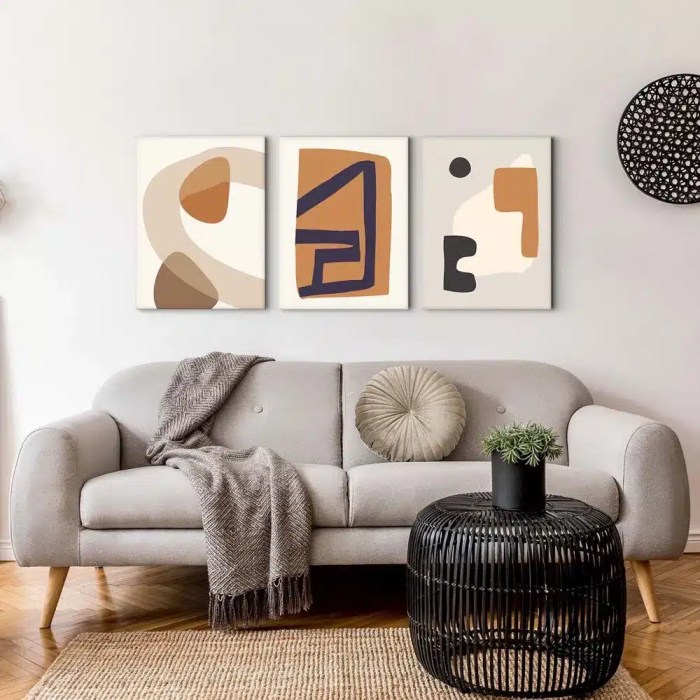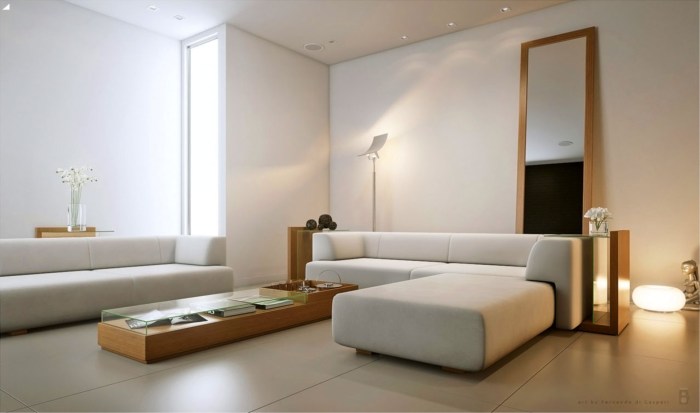Minimalist Home Decor Style & Simplicity
Minimalist Home Decor: Transform Your Space with Style & Simplicity – it sounds simple, right? But transforming your home into a minimalist haven involves more than just getting rid of stuff. It’s about intentionality, creating a space that feels calm, functional, and reflects your personal style. This guide explores the core principles of minimalist design, offering practical steps to declutter, organize, and curate a beautiful, stress-free living environment.
We’ll delve into color palettes, material choices, furniture selection, and lighting, showing you how to create a minimalist aesthetic in any room of your house.
We’ll cover everything from identifying and discarding unnecessary items to selecting the perfect furniture and lighting to create a truly serene atmosphere. Whether you’re aiming for a Scandinavian-inspired space or a more modern feel, this guide will equip you with the knowledge and strategies to achieve your minimalist home decor goals. Prepare to embrace simplicity and unlock the transformative power of less.
Defining Minimalist Home Decor
Minimalist home decor is a design philosophy that prioritizes functionality, simplicity, and intentional living. It’s about curating a space free from clutter and unnecessary items, focusing instead on quality pieces that serve a purpose and contribute to a sense of calm and order. This approach goes beyond simply owning less; it’s about thoughtfully choosing what you keep and how it’s displayed.The benefits of embracing a minimalist approach are numerous.
A clutter-free environment reduces stress and promotes a sense of peace. The intentional selection of furniture and decor items leads to a more aesthetically pleasing and harmonious space. Furthermore, minimalist living often encourages mindful consumption, reducing waste and promoting sustainability. This streamlined approach can also make cleaning and maintaining your home significantly easier.
Comparison of Minimalist Decor with Other Styles
Minimalist decor, while sharing some similarities with other styles, possesses unique characteristics that set it apart. Scandinavian design, for example, often incorporates natural materials like wood and light colors, mirroring the minimalist emphasis on simplicity. However, Scandinavian design frequently includes more texture and a warmer, cozier feel than minimalist interiors, which tend towards a cleaner, more austere aesthetic. Modern design, on the other hand, can incorporate bolder colors and more complex shapes than minimalist decor, which generally favors neutral palettes and clean lines.
Minimalist design prioritizes functionality above all else, while modern design can sometimes prioritize aesthetics over pure functionality.
Visual Representation of Minimalist Home Decor, Minimalist Home Decor: Transform Your Space with Style & Simplicity
Imagine a living room bathed in soft, natural light. The walls are painted a calming off-white, and the floor is covered in light-colored, wide-plank wood flooring. The furniture consists of a simple, low-profile sofa in a neutral gray fabric, a single, sleek coffee table made of light wood, and two comfortable armchairs in the same fabric as the sofa.
Minimalist home decor focuses on functionality and clean lines, creating a calm atmosphere. If you’re looking to add a touch of rustic charm to your minimalist space, consider incorporating natural elements. For some inspiration, check out this great resource on Top 15 Rustic Farmhouse Decor Ideas to Elevate Your Home for ideas on how to subtly blend styles.
Remember, even with rustic additions, keeping it simple and intentional will maintain the core principles of minimalist design.
A large, unframed print of a minimalist landscape hangs above the sofa, the only piece of artwork in the room. A single, carefully chosen houseplant sits in a simple ceramic pot on the coffee table. The room is uncluttered, with no unnecessary accessories or knick-knacks. Every item serves a purpose and contributes to the overall feeling of serenity and spaciousness.
The color palette is restricted to neutral tones, creating a sense of calm and sophistication. The overall impression is one of intentional simplicity and understated elegance.
Decluttering and Organization
Embracing minimalism isn’t just about aesthetics; it’s about creating a functional and peaceful living space. Decluttering and organizing are crucial steps in achieving this. By strategically removing unnecessary items and implementing effective organizational systems, you can transform your home into a sanctuary of calm and efficiency. This process is about intentionality – choosing what truly adds value to your life and letting go of the rest.
Effective decluttering involves a mindful approach, not just a frantic purge. It’s about identifying what you truly need and use, and then finding efficient ways to store and access those items. This leads to a more streamlined and visually appealing space, reducing stress and improving overall well-being. Remember, the goal isn’t to become a minimalist overnight; it’s a journey of conscious choices.
Practical Decluttering Strategies
Several strategies can make decluttering less daunting and more effective. The key is to approach the process systematically, breaking down large tasks into manageable steps. This prevents feeling overwhelmed and allows for a more sustainable approach to maintaining a clutter-free environment.
- The One-In, One-Out Rule: For every new item you bring into your home, remove a similar item. This prevents accumulation.
- The 20/20 Rule: If an item costs less than $20 to replace and takes less than 20 minutes to replace, consider discarding it if it’s not essential.
- The Four-Box Method: Use four boxes labeled “Keep,” “Donate,” “Trash,” and “Relocate.” This provides a clear system for sorting items quickly.
- Set Realistic Goals: Don’t try to declutter your entire house in a day. Focus on one area at a time to avoid feeling overwhelmed.
- Work in Short Bursts: Even 15-minute decluttering sessions can make a difference. Consistency is key.
Organizing Belongings for Maximum Space
Once you’ve decluttered, organizing your remaining belongings is essential for maintaining a minimalist aesthetic. This involves thoughtful storage solutions and strategic placement of items to maximize space and accessibility. The goal is to create a visually appealing and functional space where everything has its place.
Minimalist home decor emphasizes clean lines and functionality, creating a calm and inviting atmosphere. Extending this aesthetic to your home’s exterior is key, and you can achieve this effortlessly with the right lighting. Consider upgrading your curb appeal with stylish and energy-efficient options like Home Exterior LED Lighting , which complements a minimalist design perfectly. This subtle yet impactful addition enhances your home’s overall minimalist feel, creating a cohesive and welcoming look from the inside out.
- Vertical Space: Utilize shelves, drawers, and vertical organizers to maximize storage in closets and cupboards.
- Multi-Functional Furniture: Choose furniture that serves multiple purposes, such as ottomans with storage or beds with built-in drawers.
- Clear Containers: Use clear containers to store items, making it easy to see what’s inside and preventing clutter from building up.
- Label Everything: Labeling containers and shelves helps maintain organization and makes it easy to find items.
- Regular Purging: Schedule regular decluttering sessions (monthly or quarterly) to prevent clutter from accumulating again.
Decluttering a Kitchen Drawer: A Step-by-Step Guide
Let’s focus on a common clutter hotspot: the kitchen drawer. Following these steps will transform a chaotic drawer into an organized and efficient space.
- Empty the Drawer: Remove everything from the drawer and clean it thoroughly.
- Sort and Categorize: Group similar items together (e.g., utensils, gadgets, etc.).
- Identify Unnecessary Items: Discard or donate duplicate or rarely used items.
- Choose Storage Solutions: Select drawer dividers or organizers to maximize space and keep items separated.
- Place Items Back in the Drawer: Arrange items neatly in the drawer using the chosen organizers.
Decluttering Steps: A Four-Column Table
This table summarizes the key steps in the decluttering process, offering a visual guide to help you stay organized.
| Identify Unnecessary Items | Categorize Belongings | Discard or Donate Items | Store Remaining Items Efficiently |
|---|---|---|---|
| Ask: Do I need this? Do I use this? Does this bring me joy? | Group similar items together (e.g., clothes, books, kitchen utensils). | Donate usable items to charity; discard broken or unusable items responsibly. | Use storage solutions like containers, shelves, and drawers to keep items organized and accessible. |
Color Palette and Material Selection
Creating a truly minimalist space isn’t just about removing clutter; it’s about carefully curating a calming and stylish environment through thoughtful color choices and material selection. The right palette and materials can significantly enhance the feeling of serenity and spaciousness, while the wrong ones can easily overwhelm even the most meticulously organized room.Color palettes and material choices are fundamental to achieving a minimalist aesthetic.
The goal is to create a sense of balance and harmony, using a limited number of carefully chosen elements to maximize impact and minimize visual noise. This involves understanding how colors affect mood and how different materials contribute to the overall texture and feel of the space.
Effective Color Palettes for Minimalist Design
Neutral palettes are the cornerstone of minimalist design. These palettes prioritize calming and versatile shades that create a sense of spaciousness and tranquility. Popular choices include variations of white, beige, gray, and soft creams. These colors provide a clean backdrop that allows furniture and artwork to stand out without competing for attention. Subtle variations within a neutral palette can add depth and visual interest without disrupting the overall sense of calm.
Minimalist home decor focuses on clean lines and functional pieces, creating a calm and stylish atmosphere. But don’t forget the exterior! Before you even start decluttering inside, you might want to check out some great Home Exterior Apps to plan your curb appeal. A cohesive look, inside and out, truly elevates your minimalist design.
For example, using different shades of gray – from a light dove gray to a charcoal gray – can add complexity while maintaining a unified feel. Introducing a single accent color, such as a muted blue or a warm terracotta, can add a touch of personality without overpowering the space.
Material Selection for Minimalist Interiors
Natural materials are highly valued in minimalist design for their inherent beauty and sustainable qualities. Natural wood, in its various forms and finishes, adds warmth and texture without being visually heavy. Linen and cotton fabrics, in neutral tones, contribute to a feeling of comfort and sophistication. Stone, particularly in lighter shades, can be used effectively in flooring or countertops, creating a sense of solidity and elegance.
Metal accents, such as brushed steel or matte black, can add a touch of modernity and visual interest, but should be used sparingly to avoid overwhelming the space. The key is to select materials that are both aesthetically pleasing and durable, contributing to the overall sense of calm and order.
The Importance of Texture in Minimalist Design
While minimalism emphasizes simplicity, it doesn’t mean sacrificing texture. In fact, carefully incorporated textures can add depth and visual interest to an otherwise simple space. The interplay of different textures—the smoothness of linen against the grain of natural wood, the coolness of stone against the warmth of wool—creates a richer sensory experience without compromising the clean lines and uncluttered feel of minimalist design.
However, it’s crucial to use texture thoughtfully. Avoid overly busy or contrasting textures; instead, opt for subtle variations that complement each other and contribute to the overall sense of harmony.
Minimalist Color Palettes for Different Rooms
Three distinct color palettes are presented below, tailored to the unique atmosphere of a bedroom, living room, and bathroom.
Bedroom Color Palette
This palette centers around soft, calming shades to promote relaxation and sleep. The base color is a warm, off-white, reminiscent of creamy linen. Accent colors include a soft, muted gray for bedding and a subtle blush pink for decorative elements, creating a tranquil and inviting space. The overall effect is serene and calming, perfect for a restful night’s sleep.
Living Room Color Palette
This palette emphasizes neutral tones with a touch of warmth. The base is a light, cool gray that provides a sense of spaciousness. Accent colors include a warm, natural beige for upholstery and a deep charcoal gray for smaller details like throw pillows or a coffee table. This palette creates a sophisticated and inviting atmosphere.
Bathroom Color Palette
This palette uses a crisp white as a base, creating a sense of cleanliness and spaciousness. Accent colors include a soft, cool gray for towels and other textiles, and a natural wood tone for shelving or a vanity. This palette offers a clean, refreshing, and spa-like atmosphere.
Furniture and Decor Selection

Source: ahouseinthehills.com
Choosing furniture and decor for a minimalist home requires careful consideration. The goal is to create a space that is both functional and visually appealing, prioritizing quality over quantity and emphasizing clean lines and simple forms. Every piece should serve a purpose and contribute to the overall sense of calm and order.
Minimalist design isn’t about deprivation; it’s about intentionality. It’s about curating a collection of items that truly resonate with you and enhance your living experience, rather than accumulating possessions that clutter your space and mind. This mindful approach extends to both furniture and decorative elements.
Minimalist home decor emphasizes clean lines and functionality, creating a calm and spacious feel. This extends beyond the interior; even accessibility features can reflect this style. If you’re considering a multi-story home, check out options for Best Outdoor Elevators to maintain that sleek aesthetic. Ultimately, a minimalist approach, whether indoors or out, prioritizes both beauty and practicality.
Furniture Material Selection
The choice of materials significantly impacts the overall aesthetic and feel of a minimalist space. Natural materials like wood, often in light or neutral tones, create a warm and inviting atmosphere. Wood’s inherent texture and grain add visual interest without being overly fussy. Metal, particularly in sleek, matte finishes, contributes a modern and industrial edge, while maintaining a sense of simplicity.
Plastic, while functional, should be used sparingly in a minimalist setting, as it can often feel less refined and more mass-produced. Consider the durability, sustainability, and visual impact of each material when making your selections. For example, a solid wood coffee table will likely last longer and feel more substantial than a plastic one, aligning with the minimalist principle of investing in quality pieces.
Incorporating Artwork and Decorative Elements
While minimalism emphasizes simplicity, it doesn’t preclude the inclusion of artwork or decorative elements. The key is to choose pieces that are carefully considered and add to the overall aesthetic, rather than detracting from it. A single, striking piece of art can serve as a focal point, while a small collection of carefully curated objects can add personality without overwhelming the space.
Consider the scale, color, and texture of any decorative items to ensure they complement the overall minimalist design. For instance, a simple ceramic vase with a single stem of flowers can be far more impactful than a cluttered display of various trinkets. The focus should always be on quality over quantity, and on pieces that speak to your personal style.
Five Essential Furniture Pieces for a Minimalist Living Room
A minimalist living room doesn’t require a lot of furniture; functionality and aesthetic appeal are key. The following five pieces provide a solid foundation for a comfortable and stylish space:
- Sofa: A comfortable and well-proportioned sofa serves as the central piece of the living room, providing ample seating for relaxation and socializing. Consider a simple, modular design for flexibility.
- Coffee Table: A low coffee table provides a surface for drinks, books, and other essentials, while maintaining a sense of openness in the room. Choose a design with clean lines and a simple shape.
- Rug: A large rug anchors the seating area and adds warmth and texture to the floor. Opt for a neutral color and a simple pattern or texture.
- Side Table: A small side table provides a convenient surface for lamps, remotes, or other items within easy reach of the sofa. Its compact size prevents it from cluttering the room.
- Storage Unit: A simple storage unit or shelving unit helps keep belongings organized and out of sight, maintaining the minimalist aesthetic. Choose a piece with clean lines and ample storage space.
Lighting and Ambiance
Lighting plays a crucial role in shaping the mood and atmosphere of any space, but it’s especially important in minimalist design. A minimalist aesthetic prioritizes clean lines and simplicity, and the right lighting scheme can enhance this by highlighting key features while maintaining a sense of calm and spaciousness. Poor lighting, on the other hand, can easily clutter the visual experience and undermine the entire design.The strategic use of lighting in minimalist interiors creates a sense of depth, texture, and warmth, preventing a sterile or cold feel that can sometimes accompany stark simplicity.
Different types of lighting serve distinct purposes, contributing to a holistic and well-balanced illumination plan.
Types of Lighting in Minimalist Design
In minimalist design, a layered lighting approach is key. This involves combining ambient, task, and accent lighting to achieve a well-lit and visually appealing space. Ambient lighting provides overall illumination, task lighting focuses light on specific work areas, and accent lighting highlights architectural details or artwork. Each type contributes to the overall ambiance, creating a dynamic yet harmonious lighting scheme.
Natural Light Maximization in Minimalist Homes
Natural light is a cornerstone of minimalist design. It brightens the space, improves mood, and reduces the need for artificial lighting. Maximizing natural light involves strategic window placement, using sheer curtains or blinds to diffuse light while maintaining privacy, and opting for light-colored walls and flooring to reflect light effectively. Mirrors strategically placed can also amplify natural light, creating a brighter and more spacious feel.
For example, a large mirror positioned opposite a window in a hallway can dramatically improve the light penetration in a usually darker area.
Minimalist Kitchen Lighting Plan
Consider a minimalist kitchen with a galley-style layout. The lighting plan would incorporate the following:
- Ambient Lighting: Recessed LED downlights installed evenly across the ceiling provide a consistent base level of illumination throughout the kitchen. This ensures a well-lit space without harsh shadows.
- Task Lighting: Under-cabinet LED strip lights illuminate the countertop workspaces, providing focused light for food preparation and cooking. These lights should be bright but not glaring, ideally adjustable in brightness.
- Accent Lighting: A single pendant light, perhaps a sleek, minimalist design, hung above the kitchen island provides both task and accent lighting. This focal point adds a touch of visual interest while illuminating the island workspace. The pendant’s design should complement the overall minimalist aesthetic of the kitchen.
This layered approach ensures that the kitchen is adequately lit for all activities while maintaining a clean and uncluttered look, characteristic of minimalist design. The choice of LED lighting throughout minimizes energy consumption and contributes to the sustainable ethos often associated with minimalist living.
Transforming Different Room Types
Applying minimalist principles isn’t about stripping your home bare; it’s about curating a space that’s both beautiful and functional. By focusing on essential items and thoughtful design choices, you can transform any room into a haven of calm and style. This section will explore how to apply minimalist principles to various rooms in your home.
Minimalist Living Room Design
A minimalist living room prioritizes comfort and functionality. Instead of overcrowding the space with furniture, select a few key pieces. A comfortable sofa, a stylish coffee table, and perhaps a couple of armchairs are sufficient. Choose neutral colors for the walls and flooring, creating a sense of spaciousness. Incorporate natural materials like wood and cotton for texture and warmth.
Instead of numerous throw pillows, opt for one or two high-quality pieces. A large piece of artwork or a statement mirror can serve as a focal point, adding visual interest without cluttering the space. Avoid excessive decorations; a few carefully chosen plants can add life and vibrancy.
Minimalist Bedroom Design
The bedroom should be a sanctuary of peace and relaxation. Choose a calming color palette, perhaps soft greys, blues, or greens. A comfortable bed is the centerpiece; select bedding in natural fabrics like linen or cotton. Minimalist bedrooms often feature a simple nightstand with a lamp and perhaps a small storage space. Keep the accessories to a minimum – a few carefully chosen photographs or a small plant can add personality without overwhelming the space.
Avoid bulky furniture or excessive textiles. The goal is to create a clean, uncluttered space that promotes restful sleep.
Minimalist home decor emphasizes clean lines and functionality, creating a serene atmosphere. If you’re aiming for accessibility alongside a sleek aesthetic, consider incorporating practical elements like Outdoor Home Elevators for seamless movement between levels. This adds functionality without compromising the minimalist design, keeping your home both stylish and user-friendly.
Minimalist Kitchen Design
A minimalist kitchen is all about efficiency and clean lines. Opt for sleek, handleless cabinets in a neutral color. Choose countertops and backsplashes in a simple material, such as quartz or marble. Keep appliances to a minimum, opting for multi-functional options where possible. Open shelving can display beautiful dishes or cookware, while closed storage keeps clutter hidden.
Avoid excessive kitchen gadgets; keep only those you use regularly. A well-organized pantry is key to maintaining a minimalist aesthetic. The overall effect should be a clean, uncluttered space that’s both functional and visually appealing.
Minimalist Home Office Design
A functional and stylish minimalist home office prioritizes organization and efficiency. Choose a desk that’s large enough for your needs, but not overly bulky. A comfortable chair is essential for long hours of work. Keep storage solutions minimal but effective, perhaps a few drawers or shelves. A good quality desk lamp provides task lighting.
Incorporate plants to improve air quality and add a touch of nature. A neutral color palette creates a calming and productive environment. Minimize distractions by keeping the workspace clean and uncluttered. A simple, well-organized space will promote focus and productivity.
Minimalist Bathroom Design
Creating a minimalist bathroom that feels both spacious and relaxing involves careful selection of fixtures and accessories. Choose a neutral color palette, such as white, grey, or beige, to create a sense of openness. Select sleek, minimalist fixtures, such as a wall-mounted sink and a simple shower. Keep storage to a minimum, using built-in shelving or cabinets to maximize space.
Towels and bath mats should be in neutral colors and simple textures. A few carefully chosen plants can add a touch of life and vibrancy without cluttering the space. The overall goal is to create a clean, serene space that promotes relaxation and rejuvenation.
Wrap-Up: Minimalist Home Decor: Transform Your Space With Style & Simplicity

Source: boredart.com
Ultimately, minimalist home decor is about more than just aesthetics; it’s about creating a space that supports your well-being and reflects your values. By decluttering the physical clutter, you also declutter the mental clutter, fostering a sense of calm and focus. Remember, the journey to a minimalist home is a personal one, so embrace the process, experiment with different styles, and most importantly, create a space that truly feels like home.
Enjoy the journey of intentional living and the beauty of simplicity!
Common Queries
What’s the difference between minimalist and Scandinavian design?
While both emphasize simplicity, Scandinavian design often incorporates warmer tones and natural materials like wood, while minimalist design prioritizes functionality and a more neutral palette.
How do I start decluttering if I’m overwhelmed?
Start small! Focus on one area, like a drawer or shelf, and work your way through your home gradually. Don’t aim for perfection, just make progress.
Can minimalist design work in a small space?
Absolutely! Minimalism is perfect for small spaces as it focuses on maximizing functionality and minimizing visual clutter, making the space feel larger and more open.
Is minimalist decor expensive?
Not necessarily. Minimalism prioritizes quality over quantity, so you might invest in fewer, higher-quality items rather than accumulating lots of inexpensive things.
Where can I find inspiration for minimalist home decor?
Explore websites like Pinterest, Instagram, and design blogs for countless examples of minimalist interiors. Look at magazines, too!









